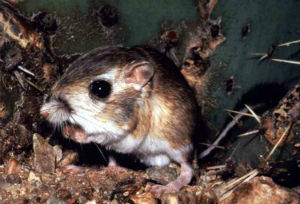Heteromyid Hybrids
Family Heteromyidae
Kangaroo rats, kangaroo mice & pocket mice
EUGENE M. MCCARTHY, PHD GENETICS, ΦΒΚ
Heteromyid Hybrids - Reported crosses:

Chaetodipus intermedius [Rock Pocket Mouse] In Arizona (southwestern U.S.), four populations (critinus, intermedius, umbrosus, phasma), have hybrid zones where they meet. That between critinus and intermedius is in the Grand Canyon area; that between umbrosus and intermedius, near Congress and Wickenburg; and that between phasma and intermedius, extends from the northwestern part of the state to Tucson, thence southward to San Miguel (ACZ, intermedius occurs above phasma). Hoffmeister 1986 (pp. 280, 284-287).
Note: Two populations (penicillatus, pricei), treated as races of Chaetodipus penicillatus, have a hybrid zone in southern Arizona. McKnight 1989.
Chaetodipus penicillatus [Sonoran Desert Pocket Mouse]
× Chaetodipus pernix [Sinaloan Pocket Mouse] NHR(northwestern Mexico). Hybrids occur in the vicinity of Vicam, Sonora. The diploid chromosome numbers of penicillatus and pernix are 2n = 46 and 2n = 52, respectively, and that of the F1 hybrids is 2n = 49. Best and Lackey 1992; Mantooth and Best 2005; Patton and Soule 1967.
Chaetodipus pernix [Sinaloan Pocket Mouse] See: Chaetodipus penicillatus.
Dipodomys merriami [Merriam’s Kangaroo Rat] Two populations (merriami, olivaceus), treated as races of D. merriami, have a wide hybrid zone in southeastern Arizona. Hoffmeister 1986 (Map 5.68 and pp. 314).
Dipodomys microps [Chisel-toothed Kangaroo Rat] Two populations (perblandus, spectabilis), treated as races of D. microps, have a narrow hybrid zone in southeastern Arizona (along the eastern slope of the Rincon, Empire, Santa Rita, and Patagonia mountains). Hoffmeister 1986 (Map 5.67 and p. 309).
Dipodomys ordii [Ord’s Kangaroo Rat] Two populations (chapmanni, longipes), treated as races of D. ordii, have a hybrid zone in northeastern Arizona (near Frazier Well and western part of the Grand Canyon’s South Rim). Two others (longipes, ordii) hybridize in central Arizona (at Cutter, Gila County). Hoffmeister 1986 (Map 5.66 and pp. 300, 303).
Dipodomys elephantinus [Big-eared Kangaroo Rat]
× Dipodomys venustus [Narrow-faced Kangaroo Rat] Grinnell (1922) thought these rats might hybridize in the Gabilan River valley (southern California) and Hawbecker (1940) said putative D. venustus from Santa Cruz Co., California represented probable hybrids. Best et al. (1996) lumped these taxa.
Heteromys desmarestianus [Forest Spiny Pocket Mouse]
× Heteromys nubicolens [Cloud-dwelling Spiny Pocket Mouse] CON: northwestern Costa Rica. Intermediate specimens (probable hybrids) have been reported. H. nubicolens was only recently treated as a separate species from H. desmarestianus. It is not listed by Duff and Lawson (2004). Anderson and Jansa 2007.
Liomys irroratus [Mexican Spiny Pocket Mouse]
× Liomys pictus [Painted Spiny Pocket Mouse] Zones of parapatric and altitudinal contact occur between these mice in western and southern Mexico (irroratus occurs above pictus). No hybrids as yet reported. Dowler and Genoways 1978; Hall and Kelson 1959.
Microdipodops megacephalus [Dark Kangaroo-Mouse]
× Microdipodops pallidus [Pale Kangaroo-Mouse] NHR(southeastern Nevada). Hybrids occur in the Penoyer Valley (Lincoln Co., n of Groom Baldy). Hall (1946, p. 380) suggests that they are partially fertile since “individuals at this locality closely resemble one another in color and in the relation of nasals to premaxillae, and are indistinguishable in length of hind foot” (i.e. megacephalus and pallidus approach each other in morphology in the Penoyer Valley, which suggests the existence of extensive gene flow). However, Hafner et al. argued that hybridization in the Penoyer Valley is minimal. Hafner et al. 1979; Hall 1941 (pp. 380-382), 1946.
Perognathus amplus [Arizona Pocket Mouse]
× Perognathus longimembris [Little Pocket Mouse] ONHR(Arizona, southwestern U.S.) Hoffmeister notes the existence of numerous probable hybrids collected west of Phoenix. Hoffmeister 1986 (p. 264).
Perognathus flavus [Silky Pocket Mouse]
× Perognathus merriami [Merriam’s Pocket Mouse] ENHI(southwestern U.S., northeastern Mexico). Lee and Engstrom concluded (1991, p. 280) that hybridization between these genetically distinct mice is limited to the vicinity of Carlsbad, New Mexico. However, a population (gilvus), usually treated as a race of P. merriami, has long been recognized as geographically and morphologically intermediate. This intermediacy was noted already by Osgood (1900, p. 23), who says that “this subspecies combines to some extent the characters of flavus and merriami.” This assertion was amply confirmed by Wilson (1973), who clearly demonstrated the morphological intermediacy of gilvus with a large-scale study. Thus, gilvus is a PHP of this cross. Presumably, hybridization occurs throughout the long contact zone, which extends well into northeastern Mexico. Also see: Findley et al. 1975.
Perognathus merriami [Merriam’s Pocket Mouse] See: Perognathus flavus.
Perognathus penicillatus [Desert Pocket Mouse] Two populations (penicillatus, pricei), treated as races of this mouse, have a narrow hybrid zone in southern Arizona (Yuma, Maricopa, Pinal, and Pima counties) where character values shift abruptly. Elsewhere the zone is broader (Graham and Colchise counties). Hoffmeister 1986 (p. 290).
Perognathus longimembris [Little Pocket Mouse] See: Perognathus amplus.
By the same author: Handbook of Avian Hybrids of the World, Oxford University Press (2006).